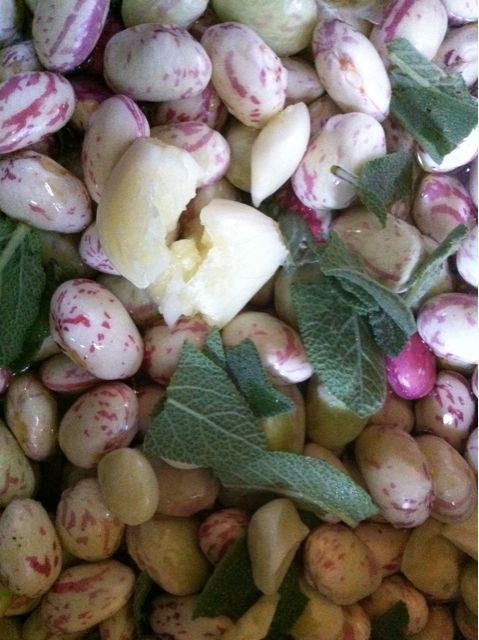You are currently browsing the category archive for the ‘vegetables’ category.
You have to admit that fresh borlotti beans are very pretty. They are also quite hard to find. Maybe that will change. It seems rather quaint now to read Elizabeth David’s advice in her book on Italian Food on how to obtain that rare and exotic vegetable, the courgette.
I hope borlotti beans don’t go quite the same way: for now, fresh ones are still unusual enough in England that it’s a special occasion when I can buy some from the farmers’ market, or find a few in a veggie box from Valvona & Crolla. Finding courgettes doesn’t have the same effect. I was quite pleased the first time I bought some courgette flowers locally, but making a meal with them reminded me of the orchid scene in Barbarella.
 Beans are rather more substantial, and last week I was lucky enough to spot some at the farmers’ market. I suppose that if they start to appear more regularly, I’ll have to find a few different ways to cook them, but while I can only get them once or twice a year, I’ll stick with Marcella Hazan’s recipe for Assunta’s beans (from her book, Marcella Cucina).
Beans are rather more substantial, and last week I was lucky enough to spot some at the farmers’ market. I suppose that if they start to appear more regularly, I’ll have to find a few different ways to cook them, but while I can only get them once or twice a year, I’ll stick with Marcella Hazan’s recipe for Assunta’s beans (from her book, Marcella Cucina).
It’s a very simple recipe: shell the beans, put them in a pan with a few cloves of garlic, a handful of sage leaves, salt, pepper, a good glug of olive oil and a bit of water. Cover the pan and simmer for one and a half to two hours.
You can eat the beans just as they are, or put them on toast. You could add tuna (Marcella approves!) to make a sort of warm version of tonno e fagioli, but I prefer them without, because you lose the clarity of flavour by mixing the beans with fish. It works best as a lightish lunch or a fairly substantial starter in the context of an English-style meal.
Unfortunately, the cooked beans are not especially pretty, because the pink and white turns to light brown, but they taste wonderful, and aren’t likely to be around for long anyway.
Yesterday’s experiments with figs made me think of the systematic approach to cooking peas that is presented in Mastering the Art of French Cooking. At the start of six pages on the subject, the authors apologise that, “we have not the space in this book to cover every aspect of pea cookery…” I’d be interested to know what aspects of pea cookery they feel they missed. Certainly there are plenty of pea recipes that aren’t included, but they give a very useful framework for making the most of your peas.
If you have perfect young, sweet, tender peas, then your job as cook is very easy. Keep it simple and let the peas speak for themselves. A brief blanching, some butter, and a little salt and pepper are all that’s needed. Actually, the Mastering team adds a tablespoon of sugar to their half pound of petit pois and to all the subsequent recipes, but I think they’re better without it.
As the peas become bigger, older, more mealy and less sweet, the cook needs to give them progressively more assistance:
- If the peas are bigger, but still quite young and sweet, boil them until they’re almost cooked, then drain them and finish them by cooking slowly in butter with salt, pepper and chopped mint.
- As the peas get a bit older, finely chopped shallot added with the butter in the final stage will give a little more sweetness and moistness. (Frozen peas get this treatment together with some chicken stock to boost the flavour.)
- Large tough peas are put in a pan with enough water to cover by ¼”and boiled for 20-30 minutes with the extras: chopped spring onion, butter, salt and pepper and the secret ingredient, shredded lettuce. Yes, it really works.
Of course, it’s useful to have detailed instructions on how to deal with any kind of pea you might encounter (there’s even advice for tinned peas) but the real lesson here is about seeing how much you need to add to your ingredients. When you’re lucky enough to get the best, your skill is to recognise it and leave it alone. When your ingredients are less than the best, then it’s time for you to add some culinary magic.
Here are a few ideas for those times when you feel nature needs a little assistance:
Tomato salad – the best just need olive oil, and a little salt. Henry Harris’s tomato and preserved lemon salad is wonderful for the others. Mix together ground cumin, chopped garlic, oregano, olive oil, red wine vinegar and salt – enough for a generous dousing of your tomatoes. Slice the tomatoes, a couple of wedges of preserved lemon, and some red onion. Scatter the onion and lemon over the tomatoes, pour the dressing over it all, and let it stand for an hour or two before you eat it. Your serving dish will probably have a tomato juice & dressing mixture left at the end, which you can save for your next salad.
Peaches – again, the best don’t need your help. The rest are good peeled, cut into wedges, and marinaded in slightly sweetened campari and orange juice (about 1 Tbsp of each per peach).
Strawberries – it sounds unlikely, but dull strawberries perk up no end if you toss them with a little balsamic vinegar. A very little is enough to boost the flavour without being obtrusive. Apparently in the Renaissance serving pepper with your strawberries was popular. I haven’t tried that yet.


